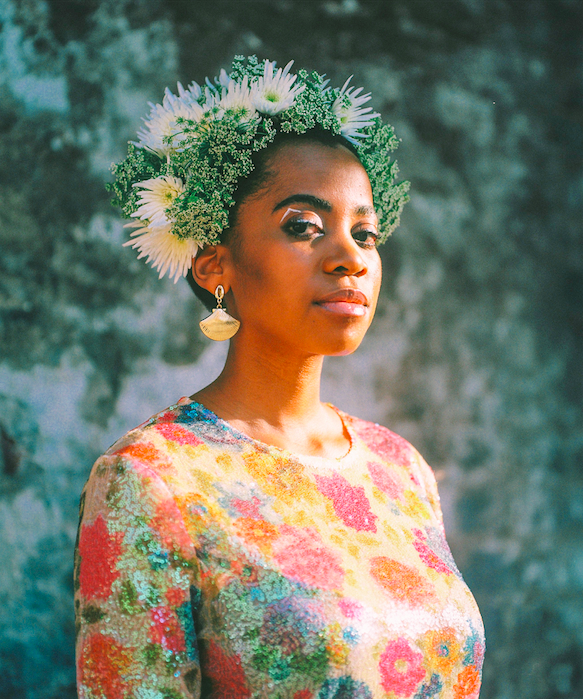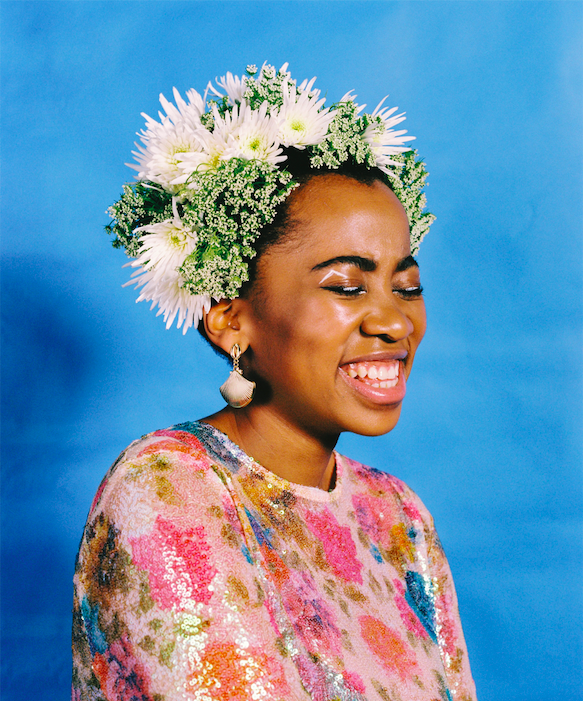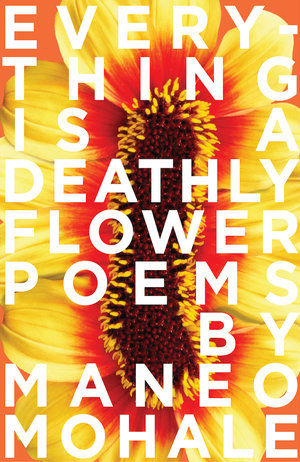Everything Is a Deathly Flower: Moments of discovery with Maneo Mohale

Ghosts don’t die, they merely sleep or hide or remain silent. Jacques Derrida speaks of “the figure of the ghost as that which is neither present nor absent, neither dead nor alive“. These ghosts, often created by confounding encounters that slowly alter the course of our lives, never fully remain in the past…..they always seem to return after long absences.
For many writers, the process of writing can be a purification and purgation of emotions, a renewal and restoration, but Mohale speaks of it as “a very painful process punctuated with little miraculous moments of discovery, a container for complicated truths”. Maneo Mohale is a prolific and thoughtful writer, editor and storyteller. Their recently published debut collection of poetry; Everything Is a Deathly Flower, confronts the ghost of a traumatic sexual assault. The book is not meant to “seek a sermon in the suicide” or find the moral lesson in the utterly cruel actions of others, it is not meant as a purge or a cleanse or a slaying of ghosts….it is simply a book of hope…….hope as seeing life with all its pain and trauma and violence, love, joy, frustration, beauty, death, absurdity, ghosts, tragedy and comedy and holding on to the willingness to live. Hope as the willingness to live wholly and joyfully.
Below is a short conversation with Mohale about the new book.
NM: Can you tell us a little bit about what compelled you to write this book and in this way —both in terms of content and in terms of form?
MM: I wrote this book because I needed to. After six years of healing and two years of writing, I felt like I could begin to approach my assault in a way that could touch at the edges of healing. Not to say that the writing itself was cathartic. It was very painful but punctuated with these little, miraculous moments of discovery. That’s why I love poetry. It’s wide and mysterious enough to be a container for complicated truths, but precise and formal enough for me to feel safe inside form and structure.
It can be so easy for our lives as black womxn, black queers or vulnerable bodies to be about violence. How do you deal with that violence, either in your work or life?
Violence is the spectre that haunts daily life – it touches everything, but unequally. As you’ve hinted at in your question, some people are more proximal to violence than others, and very often, too often, that proximity is determined by race, class, gender, ability, sexuality, etc. Especially in South Africa, where our ghosts are still so present.
In writing Everything Is a Deathly Flower, I wanted to place the violence I’d experienced in conversation with something far broader. I wanted to shift and toggle between my individual experience and a systemic critique, in a way that still felt rooted in something real and expansive. Think-pieces and traditional long-form writing make that work quite academic, polemic or jargon-heavy. But with poetry, I can really zoom into a feeling or experience, like dissociation, rage, boredom, desire, vengeance, or joy. I can point my arrows at my abuser, or I can point them at abusive people, or even better, at a fundamentally abusive and exploitative system. It always forces me to really think about violence, in the hopes that I don’t reproduce it in my aim to represent it.
I’ve heard you mention that you are stubbornly joyful, why joy or rather to begin, what is joy and what does it look like?
What a question! Whoa. Joy is my commitment to myself and what nourishes me. It’s this reckless and sharp love that I feel when I’m connected to my loves, my community, my families and my own light. It looks like growing and healing and fucking up and forgiving, and learning and shaking off the parts of my life that aren’t meant for me anymore. It’s holding myself with gentleness, and not rushing anything. I have to be stubborn about it! I’m trying really hard to place it at the centre of everything.
I’m also interested in the technicalities of how the book was brought to life, are there rituals that you found to be specific to writing poetry that differed from prose or other forms you’ve been working on?
I approached writing Everything is quite nerdily, I think. I needed spreadsheets and timetables and writing schedules and retreats. After quite a bit of trial and error, I made a spreadsheet called “The Sleeping” that separated the project into 50 distinct pieces. Because the writing was so charged and emotional, I spaced out writing days, with lots of rest and therapy in between. I’m very lucky to have received an incredible amount of support while working through The Sleeping. Of the 50 poems I wrote, 31 survived. This was after an extensive and thorough editing process with Francine Simon, my brilliant editor, and Nick Mulgrew, my wonderful (and very patient!) publisher.
I’m interested in the power of naming. Naming can mean bringing something into existence; that declaration of what something is or what something is to be considered. Can you tell us about how you name yourself through this book?
I have so many names in this book. I absorbed this idea from my people, Basotho, where a child’s name is linked to their destiny, in a way, so I name and re-name myself all over the place in the book in an effort to fiddle with this idea of fate. I even wrote a bit of a cheeky poem, “16 Days of Atavism”, where I give myself 16 names instead of the word “victim”. It ended up being a really beautiful way of reimagining how I understood my own name, as well as a way of reclaiming some of the things I’ve been called over the years.
About the title. What happens when these two words; “deathly” and “flower” are right next to each other? I’m thinking about the end of any and all possibilities with the first one and perhaps the beginning of possibilities with the second one. But also, both implying impermanence?
I really like what you’ve said about impermanence. That’s just so interesting, especially when we think about how quickly some flowers die, when cut. One of the best things about having the book out in the world is listening to people ask and talk about the title. It’s so different for everyone and that excites the literature geek in me so much. In choosing the title, which shares its name with the eldest poem in the book, I wanted to place beauty close to something seemingly insurmountable. Like an experiment, I wanted to see what they could say about each other. I’m interested in the space between things we place in binary opposition, like death and beauty. Gorgeous things happen when we dismantle binaries. I also wanted something brave and expansive, that hinted at the interconnectedness of things: hence the “everything” in the title. I’m still learning things about this title. I love it.
Stylistically, I’m interested in how the book is organised; what is the thread that weaves the edges together? What are some fun decisions you made about how the book of poems would flow?
All of the poems wink at flora in some way, most noticeably in their titles. I tried playing with language and taxonomy, naming some of them by their Latin/scientific names like “Diphylleia Grayi” (Glass Flower), which is about how transparent I felt the first time I went to therapy; or “Dionaea Muscipula (Venus Flytrap)” which reimagines my abuser’s desire as something carnivorous. Others I named by their names in Sesotho & Setswana, which was an eye-opening process of research in oral traditions, Black science and indigenous medicine. Some are really nerdy inside jokes. I also played quite a bit with epigraphs and intertextuality, as a way of inserting myself into a lineage of Black, trans and queer writers. Writing can also be really lonely, so calling voices I admire into the text was a way of feeling less alone.
You’ve been on tour and speaking about the book over the past few months, what is the reception of the book? What has been surprising to you?
I’ve loved it! To watch these poems breathe and walk and make their shaky way into people’s hands and hearts is an incredible thing. I can’t even begin to tell you what it feels like. It’s magic. I’ve been well-received, which is such a blessing, I’m just so grateful every day.
It’s also been quite intense to experience, because people sometimes respond quite viscerally, especially after a reading. I’ve had survivors come up to me at every event so far, sometimes unable to speak. Sometimes, we just hold on each other and shake. I recognise that sense of being so overwhelmed very well. I learn something new about trauma with every conversation, but also something new about survival, what it means to survive, what that looks like, or doesn’t look like, on different people. I’m constantly surprised by what poetry can do and does. I feel like I’m just getting started too, which is humbling and energising, all at once.

Image by Andile Buka
Maneo Mohale was born in 1992 in Benoni. Her work has appeared in Jalada, Prufrock, the New York Times, the Mail & Guardian, spectrum.za, among many other platforms. She currently lives and works in Johannesburg.


